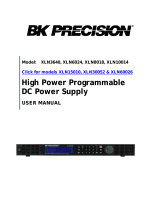
IT8900 User Manual
Copyright © ITECH Electronic Co., Ltd. vi
CONTENT
Certification and Quality Assurance ............................................................................................................................ i
Warranty service ......................................................................................................................................................... i
Limitation of Warranty ................................................................................................................................................ i
Safety signs .................................................................................................................................................................. i
Safety Precautions ...................................................................................................................................................... ii
Environmental conditions ......................................................................................................................................... iii
Regulation tag ........................................................................................................................................................... iii
Waste electrical and electronic equipment (WEEE) directive ................................................................................... iv
Compliance Information ............................................................................................................................................ v
Chapter1 Inspection and Installation ............................................................................................................. 1
1.1 Verifying the Shipment ......................................................................................................................................... 1
1.2 Instrument Size Introduction ............................................................................................................................... 1
1.3 Connecting the cabinet ........................................................................................................................................ 9
1.4 Connecting the Power Cord ................................................................................................................................. 9
1.5 Connecting Test Lines ......................................................................................................................................... 10
Chapter2 Quick Start ................................................................................................................................... 12
2.1 Brief Introduction ............................................................................................................................................... 12
2.2 Front Panel Introduction .................................................................................................................................... 13
2.3 Keyboard Introduction ....................................................................................................................................... 14
2.4 Fast function key ................................................................................................................................................ 14
2.5 Function description of VFD status indicators .................................................................................................... 15
2.6 Rear Panel Introduction ..................................................................................................................................... 15
2.7 Power-on Selftest ............................................................................................................................................... 19
Chapter3 Function and Features .................................................................................................................. 22
3.1 Switching of local/remote operation modes ...................................................................................................... 22
3.2 Constant-status operation mode ....................................................................................................................... 22
3.2.1 Constant current operation mode (CC) ....................................................................................................... 23
3.2.2 Constant voltage operation mode (CV) ....................................................................................................... 24
3.2.3 Constant resistance operation mode (CR) ................................................................................................... 25
3.2.4 Constant power operation mode (CW) ....................................................................................................... 26
3.3 Input control function ........................................................................................................................................ 27
3.4 Keyboard locking function .................................................................................................................................. 27
3.5 Short-circuit analog function.............................................................................................................................. 27
3.6 System menu function (System) ......................................................................................................................... 27
3.7 Configuration menu function (Config) ............................................................................................................... 29
3.8 Triggering function ............................................................................................................................................. 30
3.9 Dynamic test function ........................................................................................................................................ 31
3.9.1 Continuous mode ........................................................................................................................................ 31
3.9.2 Pulse mode .................................................................................................................................................. 32
3.9.3 Toggle mode ................................................................................................................................................ 34
3.10 OCP test function ............................................................................................................................................. 35
3.11 OPP test function ............................................................................................................................................. 36
3.12 Battery discharge test function ........................................................................................................................ 37
3.13 CR-LED test function ........................................................................................................................................ 38
3.14 Measurement of voltage or current rise/fall time ........................................................................................... 39
3.15 Configuration save function ............................................................................................................................. 40
3.16 VON Function ................................................................................................................................................... 41
3.17 Protective Function .......................................................................................................................................... 42
3.18 List Operation ................................................................................................................................................... 44
3.19 Terminal function of rear panel ........................................................................................................................ 46
3.19.1 Remote sense compensation functions ..................................................................................................... 47
3.19.2 External trigger function ........................................................................................................................... 47
3.19.3 External analog quantity test .................................................................................................................... 48
3.19.4 External On/Off Control ............................................................................................................................ 48
3.19.5 Voltage fault indication ............................................................................................................................. 48






















